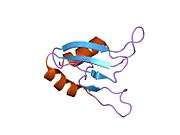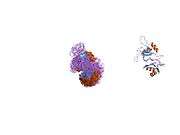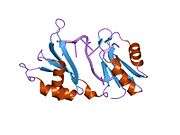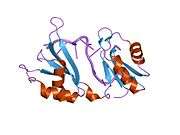ELAVL2
| ELAV like neuron-specific RNA binding protein 2 | |||||||||||||
|---|---|---|---|---|---|---|---|---|---|---|---|---|---|
|
PDB rendering based on 1d8z. | |||||||||||||
| |||||||||||||
| Identifiers | |||||||||||||
| Symbols | ELAVL2 ; HEL-N1; HELN1; HUB | ||||||||||||
| External IDs | OMIM: 601673 MGI: 1100887 HomoloGene: 20930 GeneCards: ELAVL2 Gene | ||||||||||||
| |||||||||||||
| RNA expression pattern | |||||||||||||
 | |||||||||||||
| More reference expression data | |||||||||||||
| Orthologs | |||||||||||||
| Species | Human | Mouse | |||||||||||
| Entrez | 1993 | 15569 | |||||||||||
| Ensembl | ENSG00000107105 | ENSMUSG00000008489 | |||||||||||
| UniProt | Q12926 | Q60899 | |||||||||||
| RefSeq (mRNA) | NM_001171195 | NM_001177883 | |||||||||||
| RefSeq (protein) | NP_001164666 | NP_001171354 | |||||||||||
| Location (UCSC) |
Chr 9: 23.69 – 23.83 Mb |
Chr 4: 91.25 – 91.4 Mb | |||||||||||
| PubMed search | |||||||||||||
ELAV-like protein 2 is a protein that in humans is encoded by the ELAVL2 gene.[1][2]
References
- ↑ Han J, Knops JF, Longshore JW, King PH (Feb 1997). "Localization of human elav-like neuronal protein 1 (Hel-N1) on chromosome 9p21 by chromosome microdissection polymerase chain reaction and fluorescence in situ hybridization". Genomics 36 (1): 189–91. doi:10.1006/geno.1996.0444. PMID 8812435.
- ↑ "Entrez Gene: ELAVL2 ELAV (embryonic lethal, abnormal vision, Drosophila)-like 2 (Hu antigen B)".
Further reading
- Gao FB, Carson CC, Levine T, Keene JD (1994). "Selection of a subset of mRNAs from combinatorial 3' untranslated region libraries using neuronal RNA-binding protein Hel-N1.". Proc. Natl. Acad. Sci. U.S.A. 91 (23): 11207–11. doi:10.1073/pnas.91.23.11207. PMC 45196. PMID 7972035.
- King PH, Levine TD, Fremeau RT, Keene JD (1994). "Mammalian homologs of Drosophila ELAV localized to a neuronal subset can bind in vitro to the 3' UTR of mRNA encoding the Id transcriptional repressor.". J. Neurosci. 14 (4): 1943–52. PMID 8158249.
- Gao FB, Keene JD (1997). "Hel-N1/Hel-N2 proteins are bound to poly(A)+ mRNA in granular RNP structures and are implicated in neuronal differentiation.". J. Cell. Sci. 109 (3): 579–89. PMID 8907704.
- Park S, Myszka DG, Yu M; et al. (2000). "HuD RNA recognition motifs play distinct roles in the formation of a stable complex with AU-rich RNA.". Mol. Cell. Biol. 20 (13): 4765–72. doi:10.1128/MCB.20.13.4765-4772.2000. PMC 85909. PMID 10848602.
- Strausberg RL, Feingold EA, Grouse LH; et al. (2003). "Generation and initial analysis of more than 15,000 full-length human and mouse cDNA sequences.". Proc. Natl. Acad. Sci. U.S.A. 99 (26): 16899–903. doi:10.1073/pnas.242603899. PMC 139241. PMID 12477932.
- Humphray SJ, Oliver K, Hunt AR; et al. (2004). "DNA sequence and analysis of human chromosome 9.". Nature 429 (6990): 369–74. doi:10.1038/nature02465. PMC 2734081. PMID 15164053.
- Gerhard DS, Wagner L, Feingold EA; et al. (2004). "The status, quality, and expansion of the NIH full-length cDNA project: the Mammalian Gene Collection (MGC).". Genome Res. 14 (10B): 2121–7. doi:10.1101/gr.2596504. PMC 528928. PMID 15489334.
- Yano M, Okano HJ, Okano H (2005). "Involvement of Hu and heterogeneous nuclear ribonucleoprotein K in neuronal differentiation through p21 mRNA post-transcriptional regulation.". J. Biol. Chem. 280 (13): 12690–9. doi:10.1074/jbc.M411119200. PMID 15671036.
| |||||||||||||||||
This article is issued from Wikipedia - version of the Wednesday, May 06, 2015. The text is available under the Creative Commons Attribution/Share Alike but additional terms may apply for the media files.





